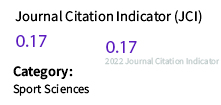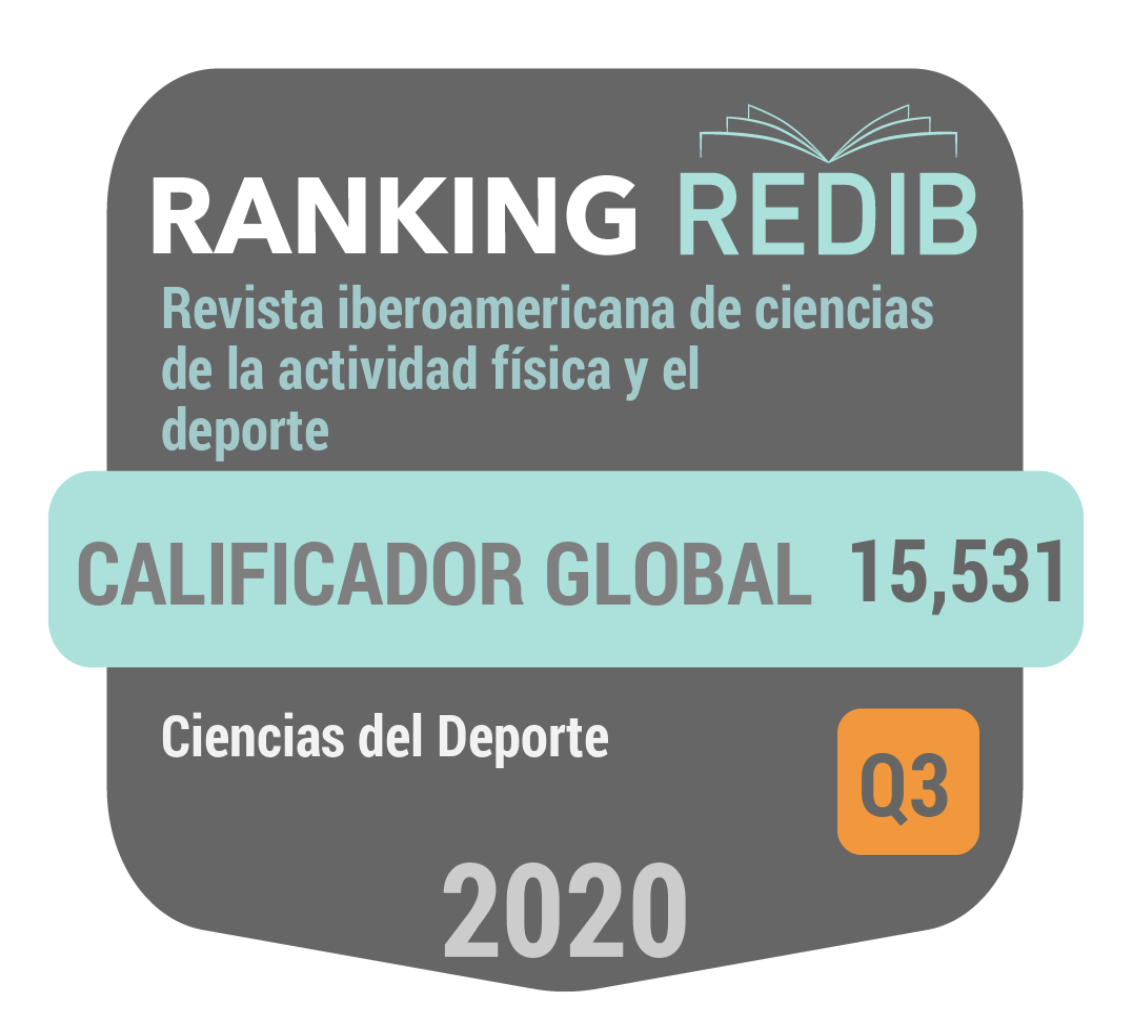Relación entre distintos test de campo de condición física en jugadores de fútbol amateur
DOI:
https://doi.org/10.24310/riccafd.2015.v4i1.6163Palabras clave:
correlación, sprint, agilidad, salto, resistencia, rendimientoResumen
El objetivo de este estudio fue analizar la relación entre distintos test de campo en jugadores de futbol. 28 jugadores de fútbol amateur fueron evaluados en la capacidad de aceleración en línea recta (5 m y 15 m), cambio de dirección (modified agility test libre, MATF), salto horizontal y vertical con contra movimiento y resistencia aeróbica (versión Level 1 del test Yo-Yo). La asociación encontrada entre la capacidad de aceleración en 15 m y el MATF (r=0,727, p<0,01), fue mayor que la obtenida entre la aceleración en 5 m y el MATF (r=0,559 p<0,01). Se observó una mejor correlación en la aceleración en 15 m que en 5 m con la capacidad tanto del salto vertical como horizontal. Posiblemente el tipo de test pueda condicionar las relaciones obtenidas entre las distintas pruebas de rendimiento.
Descargas
Métricas
Citas
Reilly, T. Bangsbo, J. Franks, A. (2000). Antropometric and physiological predispositions for elite soccer. Journal of Sports Sciences 18, 669-683.
Rebelo, A. Brito, J. Seabra, A. Oliveira, J. Krustrup, P. (2014). Physical match performance of youth football players in relation to physical capacity. European Journal of Sport Science 14, S148-156.
Chamari, K. Hachana, Y. Ahmed, Y.B. Galy, O. Sghaier, F. Chatard, J.C. Hue, O. Wisloff, U. (2004). Field and laboratory testing in young elite soccer players. British Journal of Sports Medicine 38, 191-196.
Buchheit, M. Méndez-Villanueva, A. (2013). Supramaximal intermittent running performance in relation to age and locomotor profile in highly-trained young soccer players. Journal of Sports Science 31(13), 1402-1411.
Ingebrigtsen, J. Brochmann, M. Castagna, C. Bradley, P.S. Ade. J. Krustrup, P. Holtermann, A. (2014). Relationships between field performance tests in high-level soccer players. Journal of Strength and Conditioning Research 28(4), 942-949.
Yanci, J. García, A. Castillo, D. Rivero, L. Los Arcos, A. (2014). Evaluación y relación entre distintos parámetros de condición física en futbolistas semi profesionales. Retos: Nuevas tendencias en Educación Física, Deporte y Recreación 26, 114-117.
Alricsson, M. Harms-Ringdahl, K. Werner, S. (2001). Reliability of sports related functional tests with emphasis on speed and agility in young athletes. Scandinavian Journal of Medicine and Science in Sports 11, 229 – 232.
Hulse, M.A. Morris, J.G. Hawkins, R.D. Hodson, A. Nevill, A.M. Nevill, M.E. (2013). A field-test battery for elite, young soccer players. International Journal of Sports Medicine 34, 302–311.
Svensson, M. Drust, B . (2005). Testing soccer players. Journal of Sports Science 23, 601 – 618.
Chaouachi, A. Manzi, V. Chaalali, A. Wong, P. Chamari, K. Castagna, C. (2012). Determinants analysis of change-of-direction ability in elite soccer players. Journal of Strength and Conditioning Research 26(10), 2667-2676.
Le Gall, F. Carling, C. Williams, M. Reilly, T. (2010). Anthropometric and fitness characteristics of international, professional and amateur male graduate soccer players from an elite youth academy. Journal of Science and Medicine in Sport 13(1), 90-95.
Chelly, M.S. Ghenem, M.A. Abid, K. Hermassi, S. Tabka, Z. Shephard, R.J. (2010). Effects of in-season short-term plyometric training program on leg power, jump- and sprint performance of soccer players. Journal of Strength and Conditioning Research 24(10), 2670–2676.
Los Arcos, A. Yanci, J. Mendiguchia, J. Salinero, J.J. Brughelli, M. Castagna, C. (2014). Short-term training effects of vertically and horizontally oriented exercises on neuromuscular performance in professional soccer players. International Journal of Sports Physiology and Performance 9(3), 480-488.
Ronnestad, B.R. Kvamme, N.H. Sunde, A. Raastad, T. (2008). Short-term effects of strength and plyometric training on sprint and jump performance in professional soccer players. Journal of Strength and Conditioning Research 22(3), 773-780
Edwards, A. Macfadyen, M. Clark, N. (2003). Test performance indicators from a single soccer specific fitness test differentiate between highly trained and recreationally active soccer players. Journal of Sports Medicine and Physical Fitness 43, 14-20.
Little, T. Williams, A.G. (2005). Specificity of acceleration, maximum speed and agility in professional soccer players. Journal of Strength and Conditioning Research 19(1), 76-78.
Hoff, J. Helgerud, J. (2004). Endurance and strength training for soccer players - physiological considerations. Sports Medicine 34(3), 165-180.
Mendez-Villanueva, A. Buchheit, M. Simpson, B. Peltola, E. Bourdon, P. (2011). Does on-field sprinting perfomance in young soccer players depend on how fast they can run or how fast they do run? Journal of Strength and Conditioning Research 25(9), 2634-2638.
Stølen, T. Chamari, K. Castagna, C. Wisløff, U. (2005). Physiology of soccer: an update. Sports Medicine 35(6), 501-536.
Williams, C.A. Oliver, J.L. Faulkner, J. (2011). Seasonal monitoring of sprint and jump performance in a soccer youth academy. International Journal of Sports Physiology and Performance 6, 264–275.
Salaj, S. Markovic, G. (2011). Specificity of jumping, sprinting, and quick change of direction motor abilities. Journal of Strength and Conditioning Research 25(5), 1249-1255.
Harriss, D.J. Atkinson, G. (2013). Ethical standards in sport and exercise science research: 2014 update. International Journal of Sports Medicine 34(12), 1025-1028.
Yanci, J. Los Arcos, A. Mendiguchia, J. Brughelli, M. (2014). Relationships between sprinting, agility, one and two leg vertical and horizontal jump ability in soccer players. Kinesiology 46(2),194-201.
Yanci, J. Los Arcos, A. (2014). Differences in muscle strength and leg asymmetries in elite runners and cyclists. International SportMed Journal 15(3), 265-277.
Maulder, P. Cronin, J. (2005). Horizontal and vertical assessment: reliability, symmetry, discriminative and predictive ability. Physical Therapy in Sport 6, 74-82.
Bangsbo, J. Iaia, F.M. Krustrup, P. (2008). The Yo-Yo intermittent recovery test: a useful tool for evaluation of physical performance in intermittent sports. Sports Medicine 38(1), 37-51.
Castagna, C. Impellizzeri, F.M. Rampinini, E. D'Ottavio, S. Manzi, V. (2008). The Yo-Yo intermittent recovery test in basketball players. Journal of Science and Medicine in Sport 11(2), 202-208.
Los Arcos, A. Yanci, J. Mendiguchia J. Gorostiaga E.M. (2014). Rating of muscular and respiratory perceived exertion in soccer players during competitive period. Journal of Strength and Conditioning Research 28(11), 3280-3288.
Brughelli, M. Cronin, J. Levin, G. Chaouachi, A. (2008). Understanding change of direction ability in sport. Sports Medicine 38(12), 1045-1063.
Ekblom, B. (1986). Applied physiology of soccer. Sports Medicine 3, 50-60.
Reilly, T. Thomas, V. (1976). A motion analysis of work rate in different positional roles in professional soccer match-play. Journal of Human Movement Studies 2, 87-97.
De Villarreal, E.S. Kellis, E. Kraemer, W.J. Izquierdo, M. (2009). Determining variables of plyometric training for improving vertical jump height performance: a meta-analysis. Journal of Strength and Conditioning Research 23(2), 495-506.
Miller, M.G. Herniman, J.J. Ricard, M.D. Cheatham, C.C. Michael, T.J. (2006). The effects of a 6-week plyometric training program on agility. Journal of Sports Science and Medicine 5(3), 459-65.
Kugler, F. Janshen, L. (2010). Body position determines propulsive forces in accelerated running. Journal Biomechanics 43, 343-348.
Descargas
Publicado
Cómo citar
Número
Sección
Licencia
Todos los contenidos publicados en Revista Iberoamericana de Ciencias de la Actividad Física y el Deporte están sujetos a la licencia Creative Commons Reconocimento-NoComercia-Compartirigual 4.0 cuyo texto completo puede consultar en <http://creativecommons.org/licenses/by-nc-sa/4.0>

Se pueden copiar, usar, difundir, transmitir y exponer públicamente, siempre que:
- Se cite la autoría y la fuente original de su publicación (revista, editorial y URL de la obra).
- No se usen para fines comerciales.
- Se mencione la existencia y especificaciones de esta licencia de uso.
Los derechos de autor son de dos clases: derechos morales y derechos patrimoniales. Los derechos morales son prerrogativas perpetuas, irrenunciables, intransferibles, inalienables, inembargables e imprescriptibles.
De acuerdo con la legislación de derechos de autor, Revista Iberoamericana de Ciencias de la Actividad Física y el Deporte reconoce y respeta el derecho moral de los autores/as, así como la titularidad del derecho patrimonial, el cual será cedido a la Universidad de Málaga para su difusión en acceso abierto.
Los derechos patrimoniales, se refieren a los beneficios que se obtienen por el uso o divulgación de las obras. Revista Iberoamericana de Ciencias de la Actividad Física y el Deporte se publica en open access y queda autorizada en exclusiva para realizar u autorizar por cualquier medio el uso, distribución, divulgación, reproducción, adaptación, traducción o transformación de la obra.
Es responsabilidad de los autores/as obtener los permisos necesarios de las imágenes que están sujetas a derechos de autor.






.png)








9.png)
